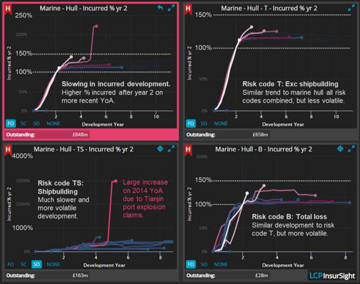
Many insurers want to make better use of data in their reserving process.
However, it can be difficult to achieve this and provide clearly communicated and timely information for financial reporting as reserving at more granular levels can significantly increase the complexity of the reserving process and the time it takes to do reserving. A good way of achieving both objectives is to:
- Do reserving projections for a manageable number of high level reserving classes to meet the financial reporting objectives of reserving.
- Analyse data driven diagnostics at more granular segmentations to make better use of the data available.

Why is it important to look at data below reserving class level?
Analysing data driven diagnostics at more granular segmentations enables you to:
- Better understand the drivers of trends at reserving class level. In particular, whether a trend is driven by a change in mix or trending on specific sub-segments. This also enables the team to more robustly assess the reasons for trends given by the wider business (eg Claims and Underwriting).
- Spot warning signs sooner by using automation to identify trends in these diagnostics at more granular levels, before they are apparent at reserving class level.
How do you get the most value from this approach?
To truly get the benefits of the this multi-level approach above you need a top down approach that focusses on the big issues, drilling down where necessary to understand drivers of these issues, and a bottom up approach to catch issues that the top down approach misses, in particular, early warning signs.
Top down – human driven process
The aims of the top down approach are to:
- Prioritise time effectively by using diagnostics to identify the main issues at reserving class level, and ensure that the reserving team’s time is focussed on dealing with these issues.
- Drill down into the data where necessary to deepen understanding of these main issues. Enabling the reserving team to provide more context and rationale for their judgements.
An example of this approach using LCP InsurSight is shown below. We start with a summary dashboard showing 6 key diagnostics for the Marine Hull reserving class.

We then drill down into Marine Hull by risk code to better understand the drivers of the trends seen in the incurred development.

The charts show the incurred development for each Year of Account (YoA) as a % of the incurred at development year 1. The fanning out trend highlighted shows that for these risk codes, more claims are incurred after year 1 than before year 1 for more recent YoA.
Bottom up – machine driven process
The aims of the bottom up approach are to:
- Identify trends across multiple data segmentations and diagnostics. The number of resulting diagnostics is often too large for it to be effective to review these manually, so an automated machine driven process that dramatically reduces the number for manual review is essential.
- Identify trends earlier by identifying them at more granular levels, before they are apparent in reserving classes.
The screenshot below is an example of this approach using LCP InsurSight’s automated trend identification to identify which risk codes have significant slowing down in premium development. This is useful as an early warning sign of softening market conditions before this is apparent in the claims data.
Having identified slowing premium development, actuaries can then pro-actively adjust claims development patterns for expected slower claims development. This gives the business a more accurate view of business performance more quickly than a reactive approach that is based purely on analysing changes in claims development.

The charts show the development of written premium for each YoA as a % of the written premium at development year 1. The fanning out trend highlighted shows that for these risk codes, more premium is written after year 1 than before year 1 on recent YoA compared to older YoA.
Summary
At first sight, making better use of data by analysing more granular data and having a manageable, efficient reserving process can appear to be conflicting objectives. However, you can achieve both objectives by having a manageable number of reserving classes and combining a human driven top down approach with a bottom up machine driven approach to make better use of data to identify early warning signs and understand claims trends. If you would like more information on LCP InsurSight, please click here.

